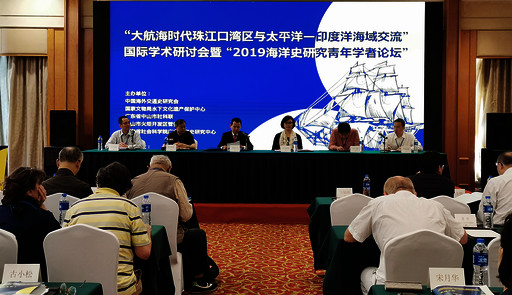
. > WHAT'S NEW > TOPLINE
Exploring historical relevance of Maritime Silk Road
Author : WU YONG and ZHOU XIN Source : Chinese Social Sciences Today 2019-12-16

The 2019 forum on maritime history studies Photo: Wu Yong/CSST
ZHONGSHAN—At the 2019 Young Scholar Forum on Maritime History Studies held recently in Zhongshan, Guangdong Province, scholars conducted in-depth discussions on hot topics in maritime history research.
Maritime transport developed tremendously in the Song Dynasty (960–1279), witnessing the invention of new tools and the accumulation of great knowledge. In the Yuan Dynasty (1271–1368), the sea-to-sea route connecting the western Pacific and the northern Indian Ocean created a preliminary form of globalization during the Age of Discovery (approximately 15th to mid-17th century).
Liu Yingsheng, a professor from the Academy of Chinese Learning at Tsinghua University, said that the Maritime Silk Road pushed the maritime transport of the western Pacific and northern Indian Ocean into a new era. Although globalization began in the era of European exploration, China’s foreign cultural exchanges were also an important driving force and the starting point of globalization.
According to Li Bozhong, a professor from the Department of History at Peking University, two profound historical changes occurred in the Ming Dynasty (1368–1644). One was the commercial revolution in China and the other was the economic globalization that began from the Age of Discovery. The inclusion of overseas international trade knowledge into China’s international trade knowledge system contributed to the rapid development of China’s international trade.
When the era of globalization began in the 16th century, the Pearl River Delta was of great significance to China. Chen Shangsheng, a professor from the School of History and Culture at Shandong University, claimed that carrying out research on the history of Chinese overseas transport in the perspective of global history, including such subjects as harbors, ports, regional trade, global trade and information exchanges, is important to thinking about how to form a consensus on the construction of a community of shared future for mankind.
Li Qingxin, director of the History and Sun Yat-sen Research Institute at the Guangdong Academy of Social Sciences, said that Macao has risen rapidly since it opened its port. It has become a maritime transport hub and one of East Asia’s globally influential centers of maritime trade, laying a solid foundation for the growth of the Greater Bay Area.
The pattern of overseas migration was the main factor driving the development of the Maritime Silk Road. Chi-Kong Lai, a reader from the School of Historical and Philosophical Inquiry at the University of Queensland, Australia, proposed that the pattern of overseas migration driven by Chinese immigrants has gradually developed into a composite multinational trade network including the flow of materials, people, capital and information. This network is also the valuable historical legacy of the Maritime Silk Road. Strengthening research on the Maritime Silk Road and regional socioeconomic development in modern times will help us deepen our understanding of China’s role in the history of global business development.
Since 1996, the protection of underwater cultural heritage in the South China Sea has entered a stage of rapid development. Sun Jian, a researcher at China’s National Center of Underwater Cultural Heritage, said that Chinese underwater archaeologists have conducted a long-term, continuous systematic investigation on underwater cultural relics in the South China Sea. They excavated the well-preserved shipwrecks of Nanhai No. 1, Nanao No. 1, Huaguangjiao No. 1, and Shanhu Island No. 1, which have provided important archaeological data for the study of the Maritime Silk Road.
At present, compared with research on the history of land trade, maritime trade research lacks physical materials. Therefore, strengthening the cooperation between archaeology and history is an important direction for future research on the history of maritime trade.
Ye Shengtao made Chinese fairy tales from a wilderness
Ye Shengtao (1894–1988) created the first collection of fairy tales in the history of Chinese children’s literature...
-
How northern ethnicities integrated into Chinese nation
2023-09-18
-
Mogao caves
2023-09-12
-
Mogao Grottoes as ‘a place of pilgrimage’
2023-09-12
-
Time-honored architectural traditions in China
2023-08-29
-
Disentangling the civilizational evolution of China
2023-08-28
-
AI ethics in science fiction
2023-08-23













 2011-2013 by www.cssn.cn. All Rights Reserved
2011-2013 by www.cssn.cn. All Rights Reserved